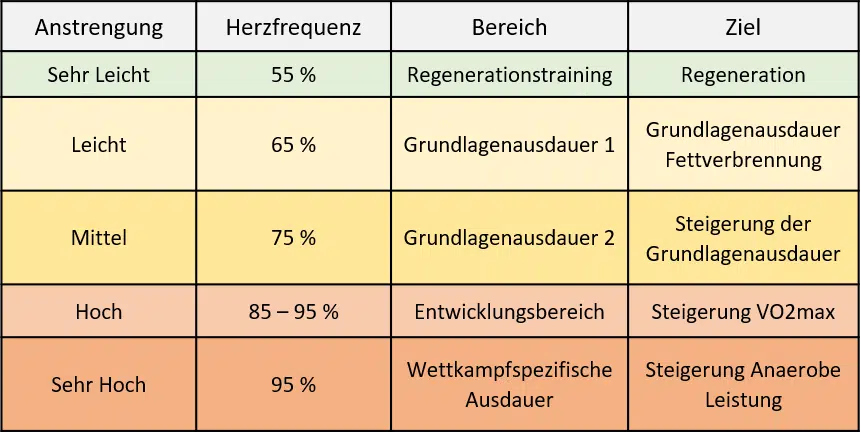In this article, you will find out how you can split up your endurance (cardiovascular) training. This will help you achieve different goals. You will also avoid overtraining and achieve the best results for your body.
What is a training area?
In endurance sports, training is divided into different training areas. The training zones differ in terms of intensity and duration.
Specifically, these ranges are determined with the help of rules of thumb or spiroergometry. These methods are used to find out the best heart rate for training, the best speed (= pace) for jogging or the best wattage for cycling.
Spiroergometry is the most accurate method for determining individual training zones. It is used in connection with endurance performance to measure oxygen uptake during physical exertion. However, spiroergometry is associated with costs and is therefore rarely used in amateur sport.
The definition of the training zones using the rule of thumb for the maximum heart rate is somewhat less precise, but free of charge and can be determined by yourself: 220 – your age. Various training zones can be derived from this, which will help you to train in a goal-oriented manner and develop your endurance in the best possible way.
There are these 5 training areas
There are different classification models depending on the sport and trainer. However, the division into these 5 training areas is widespread.
Regeneration training
This zone is used for regeneration and, if necessary, for warming up before or cooling down after training.
Training in this zone should be very relaxed. The goals are active recovery, support for cardiovascular health and the removal of harmful substances from the body. This can speed up recovery in the following days, especially after very intensive sessions.
The recommended training duration is 20 minutes to a maximum of 1 hour. Untrained people should not exceed 55% of their maximum heart rate during training, trained people should stay below 65%.
Basic endurance 1 (GA1)
GA1 training is crucial for endurance development, regardless of performance level. It promotes aerobic energy supply and fat burning at low intensity, ideally in the range of 55% to 75% of maximum heart rate. The duration of training varies between 30 minutes and 3 hours, with longer sessions being useful for competition preparation. An important feature is “running without puffing”, which means that you can talk while you run. After building up basic endurance, beginners can train more intensively in the GA2 range.
Basic endurance 2 (GA2)
In the GA2 range, training is performed at medium intensity to increase basic endurance and aerobic performance. The heart rate should be 75% – 85% of the maximum rate, with a training duration of 20 – 60 minutes. The body mainly uses oxygen to generate energy without producing lactate. Important adaptations are better oxygen utilization and increased capillarization. Recovery is crucial, 1 to 4 training sessions per week with at least one rest day are recommended.
The development area (boundary training)
In the development zone, endurance athletes train at 85% – 95% of their maximum heart rate, switching from the endurance method to the interval method. This method combines intensive phases with recovery phases, e.g. 2 km fast jogging and 1 km slow running. The training is strenuous and should only be carried out if you are in good health and have basic stamina. One to two sessions per week improve endurance and promote physical adaptations such as VO2max and cardiac muscle growth.
Competition-specific endurance (WSA)
Training in this area is a special case, as it is actually only used by competitive athletes. Experienced endurance athletes reach their limits at a heart rate of around 95% of their maximum heart rate.
High-intensity intervals are typically used for training. The athletes’ aim is to train the fast muscle fibers, the central nervous system and the anaerobic energy supply more intensively. This type of training is deliberately only used to a limited extent, as it can quickly lead to signs of overload.
Brief summary of the endurance areas

Practical tips for your endurance training
If you are a beginner runner, you should start with low-intensity training in the GA1 range. To ensure that you don’t train too intensively, you can use the formula described above as a guide and monitor your heart rate during exercise with a heart rate monitor. Alternatively, you can follow the principle of “running without puffing”. As you get fitter, slowly try GA2 training and add intervals after preparation.
If you already have experience in endurance sports, try polarized training. Train most sessions over a longer period of time at low intensity. Sometimes add interval sessions on separate days. According to current knowledge, this form of training is more effective than training at medium intensity over a longer period of time.
So: Less intensive and long or short and crisp!


